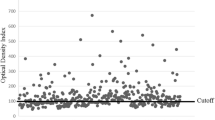Summary
Ninety-eight patients with facial paralysis were studied by an indirect enzyme-linked immunosorbent assay (ELISA) employing two types of Borrelia burgdorferi antigen, namely sonic extract and flagellum protein of B. burgdorferi. IgG or IgM antibodies were detected by sonic extract ELISA in 22 (32.4%) of 68 patients with Bell's palsy, and in 2 (10.0%) of 20 patients with varicella-zoster virus infection. This difference was statistically significant (P<0.05). A positive reaction was more frequent with the sonic extract antigen, while the positive rates were significantly increaesd in Bell's palsy patients with hyperglobulinemia (P<0.05). IgM antibodies were also significantly more frequently observed in patients who developed Bell's palsy between October and March (P< 0.05). Since none of the patients had a history suggestive of Lyme disease, some kind of non-specific reaction and certain undefined factors linked to a positive reaction against B. burgdorferi could be involved in Bell's palsy.
Similar content being viewed by others
References
Bjerkhoel A, Carlsson M, Ohlsson J (1989) Peripheral facial palsy caused by the Borrelia spirochete. Acta Otolaryngol (Stockh) 108:424–430
Burgdorferi W, Barbour AG, Hayes SF, Benach JL, Grunwaldt E, Davis JP (1982) Lyme disease: a tick-borne spirochetosis? Science 216:1317–1319
Grodzicki RL, Steere A (1988) Comparison of immunoblotting and indirect enzyme-linked immunosorbent assay using different antigen preparations for diagnosing early Lyme disease. J Infect Dis 157:790–797
Hasegawa Y (1990) A typical case of early neuroborreliosis with prominent facial diplegia. Facial Nerve Res Jpn 10: 81–84
Jonnson L, Stiernstedt G, Thomander L (1987) Tick-borne Borrelia infection in patients with Bell's palsy. Arch Otolaryngol Head Neck Surg 113:303–306
Kawabata M, Baba S, Iguchi K, Yamaguti N, Russell H (1987) Lyme disease in Japan and its possible incriminated tick vector. Ixodes persulcatus. J Infect Dis 156: 854
Kozawa T, Yanagihara N, Engstrom M, Stiernstedt G, Jonsson L (1990) Serum antibody levels to the Borrelia spirochete in Japanese patients with Bell's palsy. Acta Otolaryngol (Stockh) 110:474–476
Nagasawa A, Hakusui S, Kume A, Yasuda T, Takahashi A (1989) A case of multiple motor cranial neuropathy showing complete facial diplegia as the cardinal sign with elevated antibody titer to Borrelia burgdorferi. Facial Nerve Res Jpn 9:119–122
Olsson I, Engervall K, Asbrink E, Carlsson-Nordlander B, Hovmark A (1988) Tick-borne borreliosis and facial palsy. Acta Otolaryngol (Stockh) 105:100–107
Steere AC, Malawista SE, Snydman DR, Shope RE, Andiman WA, Ross MR, Steele FM (1977) Lyme arthritis: an epidemic of oligoarticular arthritis in children and adults in three Connecticut communities. Arthritis Rheum 20:7–17
Author information
Authors and Affiliations
Additional information
Correspondence to: M. Ikeda
Rights and permissions
About this article
Cite this article
Ikeda, M., Kawabata, M., Kuga, M. et al. Anti-Borrelia burgdorferi antibodies in patients with facial paralysis. Eur Arch Otorhinolaryngol 249, 488–491 (1993). https://doi.org/10.1007/BF00168862
Received:
Accepted:
Issue Date:
DOI: https://doi.org/10.1007/BF00168862




